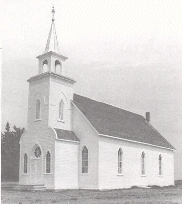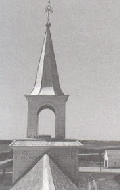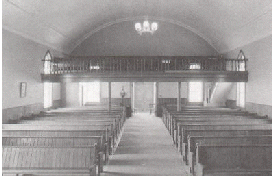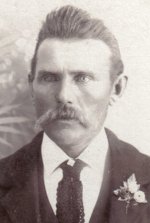One of my numerous corresponding friends, Russ Lanoway, sent me an interesting article, a chapter from the book: "
If Walls Could Talk" - Manitoba's Best Buildings Explored & Explained." The book is written by
David & Maureen Butterfield and published by
Great Plains Publications, Winnipeg. I agree with Russ that the story of Grund Lutheran Church should be of interest to the readers of this Newsletter and as permission has been given by the publishers, it follows below.
Grund Lutheran Church
The oldest Icelandic Lutheran Church in Manitoba is not located where one might suspect: at Gimli, Hecla, Arborg, or Riverton. In other words, it is not located in the main centres of New Iceland, the colony established in 1875 on the shores of Lake Winnipeg that saw the arrival of hundreds of Icelanders to Manitoba. In Fact, the province's oldest standing Icelandic church, built in 1889, stands at Grund, a south-central area of Manitoba better known for its French and Belgian settlements.

The story of this church begins in August of 1880 when Sigurdur Christopherson and Kristjan Jonsson set out for the Tiger Hills district, currently the Rural Municipality of Argyle. The two men were impressed by reports from a mutual friend Everett Parsonage, about the area's fertile and arable land. Perfect land, it would seem, for agricultural pursuits. In March of 1881 the first party of Icelandic settlers undertook the journey to this new "Paradise." The trip, which commenced in Gimli, was 323 Kilometres in length, took 16 days to complete, and was undertaken mostly on foot across snow and ice. By 1883 the settlement consisted of 17 Icelandic families. Sigurdur Christopherson continued in his immigration efforts, persuading prospective settlers in New Iceland, Ontario and even Iceland, to venture to Argyle. By 1890, 700 Icelanders lived in the district.

Religious services and scriptural readings at the new settlement were held each evening in every Icelandic home, as was the custom in the homeland. By 1884, however, with a solid population base intact, it was apparent that a formal church was needed, and on January 1st, 1884 the Frelsis Lutheran Church was formed.
Construction on the church building concluded in 1889. Two skilled carpenters - Byring Hall- grimsson and Arnie Sveinsson - oversaw the work. While it is a typical pioneer church building in many ways, incorporating a basic Gothic vocabulary typical for Protestant churches, with pointed windows and doors, a rowe window and tracery, as seen here in the second stage of the tower, the church at Grund is also distinctly Lutheran, and distinctly Icelandic.
The cultural origins of the builders fo Grund can be read into the design of the church's tower and in the composition of its interior. It was in the tower and steeple that carpenters Hallgrimson and Sveinsson recalled their northern European and Scandinavian roots. The steeple design, an elegant candle snuff shape, was a popular choice in northern European countries like Germany, Sweden and Norway. Scandinavian (or Viking) influences were expressed in the decorative criss-cross shapes at the top edge of the tower, surely an homage to the twined shapes found on so many Scandinavian objects.

Inside, the simple character of the church nave, protected by the gentle arch of the ceiling, is a loving testament to the tenets of Lutheranism.
"
What's a Grund?" The Icelandic language symbolizes the nation, its history and literature. Many settlers who struggled through daunting winter conditions on the shores of Lake Winnipeg often took time to compose poetry and prose in their native tongue. The Icelandic words included here, Grund and Frelsis mean, respectively, "grassy plain" and "freedom."
It should be of interest to the readers of this newsletter, that on October 29, 1990, the Province of Manitoba designated the Frelsis Lutheran Church at Grund as a Provincial Heritage site. The church is currently owned by the Rural Municipality of Argyle and is situated at NW Section 12, Township 6, Range 14W.
****************************
Thank you Russ for this interesting story. I'm sure that many of our readers will be looking for the book: "
If Walls Could Talk" next time they visit a bookstore.
Russ Lanoway has a family connection to the church at Grund. He wrote to me: "Hallur Thorsteinsson (1888 – 26 Feb 1934) is buried in the church cemetery at Grund. Hallur was the son of Thorunn Eyjolfsdottir (19 Dec. 1855 – 1918) and Thorstein Arnason. Thorunn was a daughter of Eyjolfur Benediktsson (1833 – 1895) who was himself an early pioneer at Breidavik, Manitoba and Eyford, North Dakota, immigrating to Canada in 1876. My wife Gwen is a granddaughter of Gudlaug Ingibjorg Eyjolfsdottir, a sister to Thorunn. As you are aware we have been doing extensive research into this family. It might interest you to know that to date, we have uncovered more than 1500 descendants of Eyjolfur Benediktsson and his first wife Thora Nikulasdottir and second wife, Solrun Ketilsdottir."
 The story of this church begins in August of 1880 when Sigurdur Christopherson and Kristjan Jonsson set out for the Tiger Hills district, currently the Rural Municipality of Argyle. The two men were impressed by reports from a mutual friend Everett Parsonage, about the area's fertile and arable land. Perfect land, it would seem, for agricultural pursuits. In March of 1881 the first party of Icelandic settlers undertook the journey to this new "Paradise." The trip, which commenced in Gimli, was 323 Kilometres in length, took 16 days to complete, and was undertaken mostly on foot across snow and ice. By 1883 the settlement consisted of 17 Icelandic families. Sigurdur Christopherson continued in his immigration efforts, persuading prospective settlers in New Iceland, Ontario and even Iceland, to venture to Argyle. By 1890, 700 Icelanders lived in the district.
The story of this church begins in August of 1880 when Sigurdur Christopherson and Kristjan Jonsson set out for the Tiger Hills district, currently the Rural Municipality of Argyle. The two men were impressed by reports from a mutual friend Everett Parsonage, about the area's fertile and arable land. Perfect land, it would seem, for agricultural pursuits. In March of 1881 the first party of Icelandic settlers undertook the journey to this new "Paradise." The trip, which commenced in Gimli, was 323 Kilometres in length, took 16 days to complete, and was undertaken mostly on foot across snow and ice. By 1883 the settlement consisted of 17 Icelandic families. Sigurdur Christopherson continued in his immigration efforts, persuading prospective settlers in New Iceland, Ontario and even Iceland, to venture to Argyle. By 1890, 700 Icelanders lived in the district. Religious services and scriptural readings at the new settlement were held each evening in every Icelandic home, as was the custom in the homeland. By 1884, however, with a solid population base intact, it was apparent that a formal church was needed, and on January 1st, 1884 the Frelsis Lutheran Church was formed.
Religious services and scriptural readings at the new settlement were held each evening in every Icelandic home, as was the custom in the homeland. By 1884, however, with a solid population base intact, it was apparent that a formal church was needed, and on January 1st, 1884 the Frelsis Lutheran Church was formed. Inside, the simple character of the church nave, protected by the gentle arch of the ceiling, is a loving testament to the tenets of Lutheranism.
Inside, the simple character of the church nave, protected by the gentle arch of the ceiling, is a loving testament to the tenets of Lutheranism.


